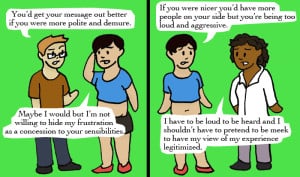
Source: Life at Thirty Something
By now, it should be no secret that allyship with trans people is a core component to intersectional feminist thought.
Yet there is still one question I consistently hear from well-intentioned friends and colleagues: “Don’t trans people validate the idea that men and women must exist within certain societal roles? Doesn’t it perpetuate gender essentialism?”
This question – conjoined with the constant assault of doubt and skepticism aimed at the entire existence of trans identities – has likely haunted a fair share of politically conscious trans activists themselves at one point or another over the course of their transition.
To answer this question, we’ll need to start by defining gender essentialism:
Gender essentialism is the idea that men and women have inherent, unique, and natural attributes that qualify them as their separate genders.
These differences are often biological or sexual, and they are almost exclusively viewed as polar opposites: Men are strong, women are weak; men are dominant, women are submissive; men have penises, women have vulvas; men have a high sex drive, women constantly need convincing; and so on and so forth.
Gross, right?
Moreover, gender essentialism fuses gender and sex to one another intrinsically. To someone promoting gender essentialism, gender and sex are identical. Naturally growing a masculine-read body, but being a woman (i.e. a trans woman) is a sheer impossibility.
This is the reason why some see transitioning as a submission to essentialist thought: Trans women and trans men are making their bodies more feminine or masculine, accordingly, and thus promoting this fusion of gender and sex. Right?
Not exactly. This assertion isn’t as cut-and-dry as it might seem.
In fact, it is absolutely possible to take a stance against gender essentialism and still continue to transition – or to support your Queer kin who are doing so.
Transition Itself Is Non-Essentialist
As I mentioned above, two core parts of gender essentialist thought are the biological and sexual assumptions that go along with a person’s definition of what it means to be a man or a woman (and being neither of these, of course, is right out of the question).
A common narrative that trans people express is that they aim to become their “true selves.”
However, striving to become one’s true self is not the same thing as the popular misconception that trans men or trans women are working to “become the opposite sex.”
The differences between these two are subtle, but important.
The first description implies that they are already men, women, or non-binary and are searching for ways to better express their reality.
The latter implies that their identity is completely invalid until they alter their bodies. Right from the get-go, we’re subjected to a cissexist perspective on trans realities.
Of course we’re going to believe that transitioning is inherently essentialist when the argument starts this way – because it has been inaccurately presented to us as inherently essentialist.
The journey to become one’s “true self” frequently passes through many places. A common one involves the person freeing themselves from the gender expression expected of people with their body and adopting one that feels more natural.
Another involves altering their body so that they can feel more comfortable in it, which allows them to reclaim it for themselves in the way that they see best fit.
Both of these self-affirmations break apart the idea that the person is permanently and biologically tied to their gender, while still affirming their right to be autonomous over their own body and to alter it to their content.
Transitioning is non-essentialist by its nature because it actively defies the idea that bodies need to or should operate in accordance with how they “naturally” operate.
It denies the presumption that our bodies have a biological predestination and queers (as opposed to maintains) the social constructs surrounding gender and our bodies.
Trans People Are Diverse
Another major reason why the “transition-as-essentialist” argument falls flat is because not every trans person is identical or wants the same things.
A full body transition is not desired by every trans person.
There are even major trans activists who promote the radical idea that trans women can actually love the body they’re in and don’t need to feel coerced to change themselves.
Conversations between trans people about their bodies, the gendering of them, and the significance and political meaning of physical transition have been happening in Western culture for as long as two trans people have been talking to one another. In fact, trans people have been defying the gendered expectations of their bodies for at least as long.
Furthermore, the argument that transitioning is inherently essentialist undermines the diversity that exists even within people who are transitioning.
Butch trans women exist.
Femme trans men exist.
Transitioning agender and non-binary people exist.
These expressions and identities, in and of themselves, subvert gender essentialist expectations by queering the binary constructs of gender, gender roles, and expectations.
A person’s decision to change their body – or advocating for increased autonomy so that they can – does not necessitate advocacy for a gender essentialist world.
Just the opposite, it adds options and opportunity for people to exist in non-essentialist ways. It opens doors for people to express their genders and reclaim their bodies where they would otherwise feel trapped.
Most importantly, it shows off the gender binary and the norm of arbitrarily gendering children for what these systems really are: broken as all hell.
Well, Okay, Maybe It’s a Little Essentialist
I’ve spent the last two sections demonizing gender essentialism and showing how it is not the sole purpose for transitioning, and I stand by those arguments.
Gender essentialism – in the way I defined it above and the way that it’s understood throughout our society – is a totally garbage concept that is largely to blame for much of the gender-based oppression within our culture.
This is obvious just by looking at how our own identities differ from the social norms that exist around us. We alone dictate that gender essentialism simply can’t be natural law.
Biologist and Queer-feminist activist Julia Serano talks about her own apprehensions toward gender essentialism in regards to her own identity in her book Excluded: Making Feminist and Queer Movements More Inclusive.
She compares the nature-vs-nurture dichotomy first by showing the flaws in gender being recognized as only genetic:
“[I]f being genetically male automatically led to a male identity, masculine gender expression, and exclusive attraction to women, [then] how did I become a bisexual femme-tomboy transsexual woman?”
Simply put, if gender essentialism were the rule, genderqueer identities just wouldn’t exist.
The ills that gender essentialism has brought women and non-binary folx has led many of these people to embrace gender artifactualism, the understanding of gender as strictly a social construction.
After all, gender norms differ from culture to culture, and they certainly don’t accurately describe every person within our own culture, so they can’t be natural or inherent to us as humans.
But Serano addresses an inconsistency with the idea that gender is exclusively a social phenomenon as well.
She describes scenarios in which male children were reassigned as female (after their “ambiguous” genitals or botched circumcisions led doctors to mandate it for them) grew up to be men or have “male-typical” traits, despite them being raised and socialized as girls.
She also touches on how this gender artifactualism doesn’t coincide with her own gender reality, using a similar argument as above:
“[If] socialization artificially brainwashes all of us into becoming heterosexual masculine men and feminine women, then how do you explain the existence of fabulous bisexual femme-tomboy transsexual women such as myself?”
Out of this conundrum, Serano concludes that there is only one explanation: Gender is neither essentialist nor artifactualist, but is both essentialist and artifactualist, each to some degree depending on the individual person. She refers to this concept as the holistic model of gender.
So while neither our biology nor our socialization exclusively dictate who we will be and how we will identify, there is evidence that both of these influences simultaneously and convolutedly guide us toward one direction or another. (This outcome should be unsurprising in a field of study that works to deny binaries and dichotomies).
From there, finding the comfort zone between self-affirmation and political idealism is up to the individual – as not every trans person is an activist, after all.
***
Gender essentialism is a tricky topic.
On one hand, it’s been used to legitimize both sexism and trans-antagonism; on the other, evidence suggests that it might not be entirely unfounded for every person.
Finding the middle ground between our bodies and our cultural influences has always been a paramount idea in feminism – and the politics of transitioning are no different.
Not to mention that advocating for and supporting transgender rights by acknowledging the diversity that exists within trans people is inherently non-essentialist, the only result that could come from progress is that more doors and opportunities will be opened for people to explore their genders and create a society that respects the full array of human experience.
[do_widget id=”text-101″]
Kaylee Jakubowski is a Contributing Writer for Everyday Feminism. She is a trans, Queer feminist with specific interests in ecofeminism, anti-imperialism, Queerness, and statistical approaches to social justice work. Xe is pursuing a B.S. in Statistics with a minor in Women’s & Gender Studies. Feel free to Like her Facebook Page, follow her on Tumblr, or see what she’s up to musically. Read her other articles here.
Search our 3000+ articles!
Read our articles about:
Our online racial justice training
Used by hundreds of universities, non-profits, and businesses.
Click to learn more
Most Read Articles
- « Previous
- 1
- …
- 30
- 31
- 32



















